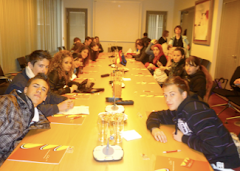After going up the blue stairs we arrived at the guard room where the guards of The Emperor Franz Joseph posted. They protected the door to his private apartments.
I was quite fascinated by the following room, the billiard room. The billiard table has been there since 1830 when members of his government or high-ranking military staff came. They were allowed to play while they waited to be received.

Franz Joseph spent almost his whole live in his study room. He started his day at five o'clock in the morning and while working he just had simple meals. This room wasn't like the others. Here there were a lot of paintings and private photographs, most from Empress Elisabeth. Two large portraits show himself at the age of 33 and his wife.
Next room was Franz Joseph's Bedroom. He got up at four o'clock, washed himself with cold water and as a strict Catholic he was, he said his prayers every morning. Inside the room there was a bed made out of iron where he died at the age of 86, in 1916. On the left side of the room there was his English-toilet.
Then we saw Elisabeth stairs cabinet where she wrote her letters, diaries and poems. Empress Elisabeth spent a few hours in her dressing room everyday. She had very long hair so her hairdresser was the first woman. She was allowed to work our of her house because Sissi trusted her so much, that she asked Franz Joseph if she could work for her.
Franz Joseph and Elisabeth shared a bedroom but it was only used during the first years of their marriage.
The reception room of the Empress was redecorated in 1854. The clock in front of the mirror on the window side of the room is very interesting. It has a reversed face at the back so that you can see the time just with a glance at the mirror.
The family dining room was also called the Marie Antoinette Room. The emperor himself said that those who sat there were allowed to talk across the table, whereas at court dinners one could only converse with one's immediate neighbour in an undertone.
The yellow salon was the bedroom of Emperor Francis Stephen.
At the age of six Mozart had given his first concert in the mirrors room, in front of the Empress Maria Theresa.
In the carousel room there were two big pictures. One of them was showing the Ladies carousel of carriage parade.
The last room we saw was the hall of Ceremonies. Here was where the family used to celebrate christenings, name-days and birthdays.
Bea Garrido
and here a personal opinion...
On 17th April, our teachers organised a visit to this palace. We arrived there at 2 o'clock and we had to wait to enter until half past two.
We visited every room in the Palace and I liked the tour very much. Especially because the guide did not give us information about what he Palace was made of or boring things like that. She told us things about Maria Teresa and her family lives, how did they used to behave and so on. It was very interesting.
I was surprised to know that the Empress Sissy was so worried about fashion. Her waist was about 52 centimetres! Can you believe that? It's incredible!
At the end of the visit, we saw a picture which was hung in the last room. The guide told us that the painter had spent almost five years painting it, because he had to see everyone to paint their faces as exactly as possible. It must have been a terribly hard work!
When the visit finished, we had the opportunity of dressing ourselves like Princes and Princesses! We really enjoyed ourselves. It was a very good experience, I'll never forget it.
by Ana
Naschmarkt
Last Saturday we went to Naschmarkt, it is the most popular market in Vienna.
Naschmarkt history is very interesting. It was born in 16th century when mainly milk bottles were sold. From 1793 onwards, all fruit and vegetable brought to Vienna by cart had to be sold here.
Every Saturday you can buy here fresh fruit and vegetables from around the world, exotic herbs, cheese, baked goods such as bread, Kaiser Rolls and torte, meat, and seafood too. And you can also enjoy a meal in any of the very good restaurants that are there, where you can try sushi, kebab, fish, seafood, and typical food from Vienna. But this is not all, if you want to you can also buy clothes and some complements here, like our ``rastro´´ in Spain.

We enjoyed the excursion very much, ate at a kebab, and later we bought a pair of sunglasses.
by Carlos & Christoph
